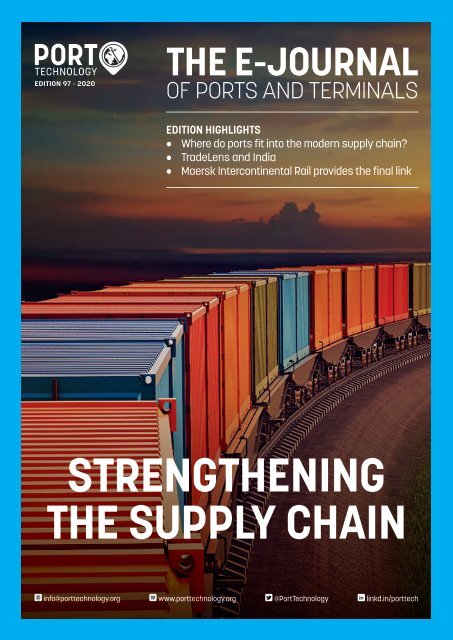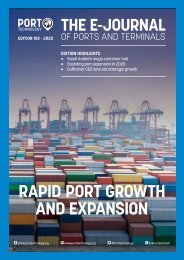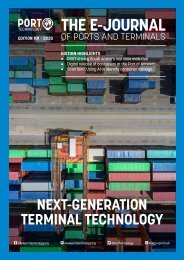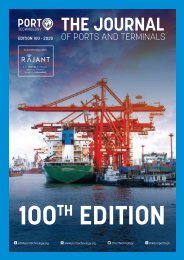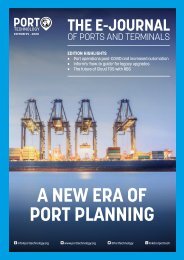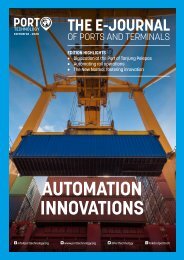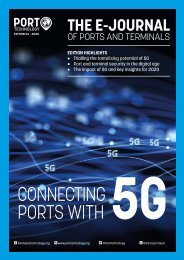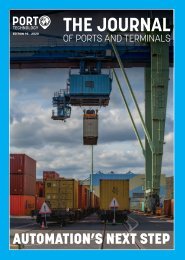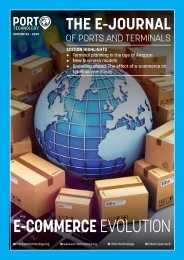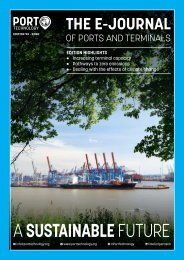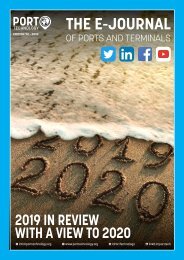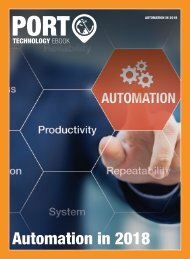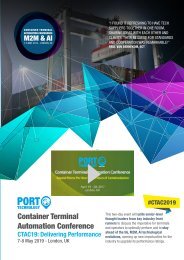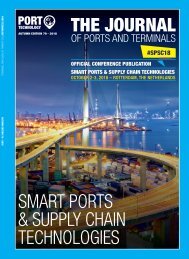Strengthening the Supply Chain
The supply chain is evolving, and the current COVID-19 pandemic is putting it under more pressure than it ever has been before. It is therefore imperative that ports and the entire logistics chain is as efficient and flexible as it can possibly be. One thing that many within the port and maritime industry have agreed upon is that this crisis will accelerate the adoption of new technologies throughout the supply chain. Blockchain for instance has been touted as a key technology that could fix the disconnect that has been revealed because of the COVID-19 crisis, this according to the World Economic Forum. The opportunity for innovation now extends beyond the port and in this e-Journal we explore how rail can play its part in meeting new customer demands, what TradeLens can offer the likes of the mega supply chain in India, and how the Port of Rotterdam leads the way in connecting ports across the globe. In addition, A.P. Moeller-Maersk provides an evaluation of how its Intercontinental Rail Service is providing customers another logistics platform for the movement of freight beyond the port.
The supply chain is evolving, and the current COVID-19 pandemic is putting it under more pressure than it ever has been before.
It is therefore imperative that ports and the entire logistics chain is as efficient and flexible as it can possibly be.
One thing that many within the port and maritime industry have agreed upon is that this crisis will accelerate the adoption of new technologies throughout the supply chain.
Blockchain for instance has been touted as a key technology that could fix the disconnect that has been revealed because of the COVID-19 crisis, this according to the World Economic Forum.
The opportunity for innovation now extends beyond the port and in this e-Journal we explore how rail can play its part in meeting new customer demands, what TradeLens can offer the likes of the mega supply chain in India, and how the Port of Rotterdam leads the way in connecting ports across the globe.
In addition, A.P. Moeller-Maersk provides an evaluation of how its Intercontinental Rail Service is providing customers another logistics platform for the movement of freight beyond the port.
Create successful ePaper yourself
Turn your PDF publications into a flip-book with our unique Google optimized e-Paper software.
EDITION 97 - 2020<br />
THE E-JOURNAL<br />
OF PORTS AND TERMINALS<br />
EDITION HIGHLIGHTS<br />
• Where do ports fit into <strong>the</strong> modern supply chain?<br />
• TradeLens and India<br />
• Maersk Intercontinental Rail provides <strong>the</strong> final link<br />
STRENGTHENING<br />
THE SUPPLY CHAIN<br />
info@porttechnology.org www.porttechnology.org @PortTechnology linkd.in/porttech
P O R T S & T E R M I N A L S
STRENGTHENING<br />
THE SUPPLY CHAIN<br />
FROM THE<br />
EDITOR<br />
The supply chain is evolving, and <strong>the</strong> current COVID-19 pandemic<br />
is putting it under more pressure than it ever has been before. It is<br />
<strong>the</strong>refore imperative that ports and <strong>the</strong> entire logistics chain is as<br />
efficient and flexible as it can possibly be.<br />
One thing that many within <strong>the</strong> port and maritime industry have<br />
agreed upon is that this crisis will accelerate <strong>the</strong> adoption of new<br />
technologies throughout <strong>the</strong> supply chain. Blockchain for instance<br />
has been touted as a key technology that could fix <strong>the</strong> disconnect<br />
that has been revealed because of <strong>the</strong> COVID-19 crisis, this according<br />
to <strong>the</strong> World Economic Forum.<br />
The impact of <strong>the</strong> crisis on trade is to continue to be dramatic. It<br />
is expected that global trade will decline quarter-on-quarter by 27%<br />
and container volumes will drop at an equally dramatic rate due to<br />
<strong>the</strong> impact COVID-19, according to <strong>the</strong> Committee for <strong>the</strong> Coordi-<br />
nation of Statistical Activities in a report organised by UNCTAD.<br />
However, ports have mostly remained fully operational during<br />
<strong>the</strong> crisis, a testament to <strong>the</strong>ir strength and durability. Protecting<br />
<strong>the</strong> supply chain has also become imperative and <strong>the</strong> likes of <strong>the</strong> UK<br />
government have invested millions to protect freight routs from <strong>the</strong><br />
worst effects of <strong>the</strong> COVID-19 pandemic.<br />
The opportunity for innovation now extends beyond <strong>the</strong> port and<br />
in this e-Journal we explore how rail can play its part in meeting<br />
new customer demands, what TradeLens can offer <strong>the</strong> likes of <strong>the</strong><br />
mega supply chain in India, and how <strong>the</strong> Port of Rotterdam leads<br />
<strong>the</strong> way in connecting ports across <strong>the</strong> globe.<br />
In addition, A.P. Moeller-Maersk provides an evaluation of how its<br />
Intercontinental Rail Service is providing customers ano<strong>the</strong>r logistics<br />
platform for <strong>the</strong> movement of freight beyond <strong>the</strong> port.<br />
Beth Maundrill<br />
Editor<br />
CONTENTS<br />
3. WHERE DO PORTS FIT INTO THE MODERN SUPPLY CHAIN?<br />
Max Schwerdtfeger, Online Editor, Port Technology International<br />
6. Q&A WITH KASPER KROG, HEAD OF INTERCONTINENTAL RAIL,<br />
A.P MOLLER – MAERSK<br />
10. MOVING TOWARDS A GLOBAL NETWORK OF PORTS<br />
Jan Gardeitchik, Business Development Manager Digital,<br />
Port of Rotterdam<br />
14. TRADELENS AND INDIA: BLOCKCHAIN, PROGRESS AND<br />
OPPORTUNITIES<br />
Bimal Kanal, Director of TradeLens, Indian Subcontinent<br />
16. BRINGING BULK OPERATIONS INTO THE MODERN AGE<br />
Beth Maundrill, Editor, PTI, spoke to Roger Clasquin,<br />
Chief Commercial Officer, RAK Ports<br />
18. SMART PORTS: BEYOND BUSINESS AS USUAL<br />
Alexandre Sánchez, Project Manager, Fundación Valenciaport<br />
info@porttechnology.org www.porttechnology.org<br />
@PortTechnology linkd.in/porttech<br />
EDITION 97 1
Less Wait.<br />
More Freight.<br />
Saving 18 seconds on an automated<br />
landside box-to-chassis landing or<br />
pickup could give you an extra<br />
1000+ boxes of throughput a day<br />
in your yard.<br />
At TMEIC, we’re using advanced<br />
automated landside transfer<br />
to change <strong>the</strong> way you think<br />
about time.<br />
To learn more, contact our experts<br />
or visit us online.<br />
TMEIC.COM<br />
2060 Cook Drive<br />
Salem, Virginia 24153 U.S.A.<br />
+1-540-283-2000
STRENGTHENING<br />
THE SUPPLY CHAIN<br />
WHERE DO PORTS FIT INTO<br />
THE MODERN SUPPLY CHAIN?<br />
Max Schwerdtfeger, Online Editor, Port Technology International<br />
The global economy is changing fast and<br />
ports cannot be static if <strong>the</strong>y are to remain<br />
competitive, let alone prosper. However,<br />
<strong>the</strong> reality is that <strong>the</strong> pressure on ports<br />
has increased rapidly in recent years as <strong>the</strong><br />
supply chain has become hyper-competitive<br />
and ever more demanding.<br />
Added to that is <strong>the</strong> need to comply with<br />
environmentally friendly regulations and<br />
<strong>the</strong> additional obstacle of new and uncertain<br />
tariffs because of <strong>the</strong> US-China trade<br />
war. These facts have already laid out uncertain<br />
foundations before we even consider<br />
<strong>the</strong> COVID-19 pandemic, which has<br />
suspended or stopped many industries outright<br />
and threatened global trade.<br />
For those reasons, ports must find new<br />
ways of doing business and fashion a new<br />
role in <strong>the</strong> global economy. That means investing<br />
in new technologies, becoming more<br />
transparent and delivering a multi-faceted<br />
service that offers more than a convenient<br />
spot for delivering and collecting containers.<br />
They must ask <strong>the</strong>mselves: where do we<br />
fit into a supply chain that is faster, greener<br />
and broader than ever before, where <strong>the</strong><br />
end consumer demands more to be delivered<br />
in less time? How can we facilitate <strong>the</strong><br />
trade on which we depend and remain competitive?<br />
How can we collaborate more with<br />
o<strong>the</strong>r ports and supply chain stakeholders?<br />
E-COMMERCE EXPLOSION<br />
If we were to narrow all <strong>the</strong> challenges<br />
ports face down to one single market<br />
phenomenon, it would be <strong>the</strong> explosion<br />
in e-commerce. The accessibility of digital<br />
technology coincided with <strong>the</strong> opening of<br />
new manufacturing hubs in Asia and South<br />
America at <strong>the</strong> turn of <strong>the</strong> century and<br />
led to a near exponential increase in <strong>the</strong><br />
amount of goods bought online.<br />
For example, it is predicted that by 2021<br />
<strong>the</strong> e-commerce industry could be worth as<br />
much as $4.9 trillion, which would be approximately<br />
double what it was in 2017, according<br />
to e-commerce specialists Statista.<br />
In <strong>the</strong> US alone, e-commerce represents<br />
10% of annual retails sales, a figure which is<br />
expected to grow by 15% each year.<br />
This in turn has created a separate revolution<br />
in <strong>the</strong> market for asset-tracking smart<br />
technologies such as sensors for <strong>the</strong> Internet<br />
of Things (IoT) and blockchain, utilisation<br />
of which has grown globally.<br />
By 2023 IoT alone could track up to 500<br />
million assets globally, with <strong>the</strong> number of<br />
installed devices expected to reach 8.9 million<br />
by 2022.<br />
There are numerous consequences to<br />
this, both physical and digital. The more<br />
TEU <strong>the</strong>re is to carry, <strong>the</strong> larger fleets must<br />
become. Since <strong>the</strong> overcapacity crisis following<br />
<strong>the</strong> global financial crash in 2008,<br />
carriers have opted for increasingly large<br />
mega-ships to meet demand.<br />
The knock on effect of this is that larger<br />
ships mean deeper quays and bigger cranes<br />
to reach <strong>the</strong> containers, as well as expanded<br />
storage capacity and more transportation<br />
from <strong>the</strong> yard to <strong>the</strong> hinterlands beyond.<br />
There is also <strong>the</strong> need for greater visibility<br />
across <strong>the</strong> supply chain; as <strong>the</strong> trade grows,<br />
so does <strong>the</strong> amount of data it generates,<br />
particularly shipping documents.<br />
Traditionally, such paperwork was filled<br />
in manually and this is still surprisingly common<br />
today. In practice it this involves re-<br />
EDITION 97 3
STRENGTHENING<br />
THE SUPPLY CHAIN<br />
questing data from multiple parties across<br />
<strong>the</strong> supply chain. Because <strong>the</strong> information<br />
is not readily visible, it raises <strong>the</strong> risk of<br />
transit milestones being missed, which subsequently<br />
lead to incurred costs, such as rerouting<br />
or storage.<br />
These can best be avoided by <strong>the</strong> aforementioned<br />
IoT tracking solutions, which<br />
can bring data toge<strong>the</strong>r into one platform<br />
for quick, easy and accurate tracking, at<br />
which point automation can speed up <strong>the</strong><br />
logistics process by removing barriers and<br />
reducing risks.<br />
This allows for stakeholders to pinpoint<br />
<strong>the</strong> movement of containers across <strong>the</strong><br />
world, but more importantly it allows for<br />
easy identification of areas where <strong>the</strong> supply<br />
chain might break down.<br />
One of those areas is <strong>the</strong> ‘last mile’, a<br />
common term to describe <strong>the</strong> final leg of<br />
a cargo’s journey from transportation hub<br />
to <strong>the</strong> end consumer, and it is here where<br />
perhaps we see biggest consequence of <strong>the</strong><br />
e-commerce and globalisation boom, <strong>the</strong><br />
enigmatic ‘Amazon Effect’.<br />
THE AMAZON EFFECT<br />
The Amazon Effect describes <strong>the</strong> need<br />
to get goods from origin to consumer as<br />
quickly as possible, <strong>the</strong> biggest hurdle being<br />
<strong>the</strong> ‘last mile’. Consumers buy more online<br />
than ever before, to <strong>the</strong> point where<br />
<strong>the</strong> global economy is almost dependent<br />
on e-commerce. Consumer demand and<br />
expectations have increased alongside it,<br />
to <strong>the</strong> point where <strong>the</strong>y expect to receive<br />
<strong>the</strong>ir products within 48 hours, as opposed<br />
to <strong>the</strong> five days which was once customary.<br />
Before <strong>the</strong> US-China trade war and <strong>the</strong><br />
COVID-19 pandemic, stakeholders across<br />
<strong>the</strong> supply chain, including ports, were reconsidering<br />
exactly how to meet <strong>the</strong> demands<br />
placed upon <strong>the</strong>m by an economy<br />
which is growing at an unrelenting pace.<br />
The added uncertainty brought about<br />
by those two external pressures combined<br />
with <strong>the</strong> changing market is forcing ports to<br />
once again reconsider how <strong>the</strong>y fit into <strong>the</strong><br />
supply chain, and <strong>the</strong> next step could be a<br />
full-scale overhaul of operations.<br />
PORTS AND LOGISTICS<br />
This is where <strong>the</strong> concept of port-centric<br />
logistics (PCL) comes in. PCL is <strong>the</strong> transformation<br />
of a port from being a point of importing<br />
and exporting goods, to becoming<br />
a fully integrated part of <strong>the</strong> supply chain,<br />
an irreplaceable hub of digital innovation<br />
that encourages collaboration among o<strong>the</strong>r<br />
stakeholders.<br />
Like so much else, as far as stakeholders<br />
are concerned PCL ends up having a different<br />
meaning depending on <strong>the</strong>ir place in<br />
<strong>the</strong> supply chain, and subsequently <strong>the</strong>ir<br />
needs would vary. Freight forwarders, port<br />
planners and shippers would need to ask<br />
<strong>the</strong>mselves if <strong>the</strong> port in question best suits<br />
<strong>the</strong>ir own business requirements.<br />
Port and urban planners will also need to<br />
also examine how unused brownfield space<br />
can be utilised, a particularly important<br />
point as ports and cities are usually very<br />
close to each o<strong>the</strong>r.<br />
How <strong>the</strong> term is defined is still up for<br />
debate but ports must be ready to meet<br />
<strong>the</strong> challenge and cater to specific needs if<br />
thy are to prosper or risk being left behind.<br />
This is evident in <strong>the</strong> way carriers have responded<br />
to <strong>the</strong>ir own crisis of overcapacity.<br />
Not only have carriers expanded <strong>the</strong>ir fleets<br />
by way of mega-ships, as we have seen, but<br />
<strong>the</strong>y have also formed alliances to optimise<br />
resources and cut costs.<br />
In addition, <strong>the</strong> world’s biggest carriers<br />
are increasingly seeing <strong>the</strong>mselves as<br />
integrated end-to-end logistics providers<br />
and have invested heavily across <strong>the</strong> supply<br />
chain to ensure a smooth service that<br />
meets end consumer expectations. A.P.<br />
Moeller-Maersk (Maersk), <strong>the</strong> largest carrier<br />
in <strong>the</strong> world, is <strong>the</strong> most prominent<br />
example of this, as it has invested in warehouses,<br />
freight hubs and short haul carriers<br />
across <strong>the</strong> supply chain.<br />
Terminal operators, with whom ports already<br />
work very closely, are doing likewise,<br />
with enabling end-to-end trade being <strong>the</strong><br />
core of <strong>the</strong>ir business strategy. DP World, for<br />
example, is developing a range of secondary<br />
services for importers and exporters, from<br />
inventory and warehouse management, <strong>the</strong><br />
objective of driving growth and accelerating<br />
<strong>the</strong> speed at which goods are transported.<br />
Fitting into <strong>the</strong> demands of a supply<br />
chain requires a fundamental realigning of<br />
port resources. In <strong>the</strong> instance port-centric<br />
logistics, this includes warehousing, as terminal<br />
operators are already exploring, and<br />
it is one of <strong>the</strong> areas of a port’s operation<br />
that has seen, and continues to see, <strong>the</strong><br />
largest reappraisal of value.<br />
Until very recently warehouses were<br />
seen as more of a burden for ports, but that<br />
has fundamentally changed along with <strong>the</strong><br />
e-commerce boom and <strong>the</strong> need for ports<br />
to respond accordingly to meet user’s last<br />
mile, or time-to-delivery, needs. A good example<br />
of this is <strong>the</strong> concept of drop shipping,<br />
an increasingly popular supply chain<br />
trend that involves retailors transfer orders<br />
to manufacturers or wholesalers, who <strong>the</strong>n<br />
transfer goods directly to customers; <strong>the</strong><br />
retailors never handle <strong>the</strong> product.<br />
This has allowed said retailors to cut<br />
costs and increase profit margins, and <strong>the</strong><br />
trend is growing at such a rate that <strong>the</strong>re<br />
are now service providers who specifically<br />
offer drop shipping warehouses. The<br />
growing importance of warehouses to <strong>the</strong><br />
supply chain and ports’ place within it has<br />
demanded greater use of automation technology,<br />
in much <strong>the</strong> same way it is across all<br />
terminal operations. Collaborative robotics,<br />
forklifts, AI and much else that is being put<br />
to good use in <strong>the</strong> yard is also required in<br />
<strong>the</strong> warehouse.<br />
This is just a very brief example of how<br />
ports can utilise <strong>the</strong>ir physical assets to better<br />
place <strong>the</strong>mselves on <strong>the</strong> supply chain.<br />
The central component of port-centric logistics<br />
is just that, transforming a port from<br />
a convenient thoroughfare for goods into<br />
an indispensable part of a wider digital ecosystem.<br />
In order to fully find that place, ports<br />
need to get smarter, in o<strong>the</strong>r words, become<br />
smart ports, those which utilises<br />
automation, IoT, artificial intelligence and<br />
machine learning to become a digital node<br />
in fast accelerating supply chain that is itself<br />
smart and also relentless.<br />
The Port of Rotterdam, for example,<br />
is pursuing an objective to become <strong>the</strong><br />
world’s smartest port, but <strong>the</strong>re are also<br />
o<strong>the</strong>rs – Algeciras, Hamburg, Dubai and Singapore<br />
are all utilising smart technologies<br />
to tap overcome challenges and make <strong>the</strong><br />
most of new opportunities, helping redefine<br />
<strong>the</strong> role and position of this previously<br />
conservative industry in <strong>the</strong> supply chain.<br />
4 EDITION 97<br />
WWW.PORTTECHNOLOGY.ORG
Kuenz FREERIDER.<br />
High efficiency in every situation.<br />
Kuenz GmbH | 6971 Hard - Austria<br />
T +43 5574 6883 0 | www.kuenz.com
Q&A WITH<br />
KASPER KROG<br />
KASPER KROG<br />
HEAD OF INTERCONTINENTAL RAIL<br />
AT A.P. MOLLER – MAERSK<br />
Speaking exclusively with Port Technology<br />
International, Kasper Krog, Head of Intercontinental<br />
Rail at A.P. Moller – Maersk,<br />
looks beyond <strong>the</strong> port and to <strong>the</strong> railways<br />
as an integral part of <strong>the</strong> supply chain.<br />
HOW DOES AN INTERCONTINENTAL RAIL<br />
SERVICE FIT INTO THE WIDER SUPPLY CHAIN<br />
AND WHAT BENEFITS DOES IT BRING?<br />
Maersk Intercontinental Rail covers <strong>the</strong> gap<br />
between air and ocean freight and is a suitable<br />
mode of transport for those customers<br />
who are looking for a more flexible and<br />
fast-moving supply chain to a competitive<br />
price complementing our integrated offerings.<br />
Customers are increasingly focused<br />
on speed to market, lower costs per unit,<br />
keeping stocks low, improving coordination<br />
and visibility around <strong>the</strong> value chain. This<br />
is why with rail we are able to offer <strong>the</strong>m<br />
<strong>the</strong> option of moving goods across multiple<br />
modes via one channel. It goes well with<br />
our strategy as it is a door to door solution<br />
complementing our Ocean products.<br />
SEVERAL ROUTES HAVE BEEN ANNOUNCED<br />
THIS YEAR, WHAT ARE THE KEY<br />
CONSIDERATIONS WHEN OPENING UP A<br />
ROUTE, WHAT IS NEXT?<br />
The demand and customer needs are <strong>the</strong><br />
main considerations when looking into<br />
opening up new routes. We are always on<br />
<strong>the</strong> lookout how to improve customer experience<br />
and provide <strong>the</strong>m with options<br />
which can simplify <strong>the</strong>ir supply chains and<br />
enable <strong>the</strong>m to run <strong>the</strong>ir business in <strong>the</strong><br />
best possible way. Expanding existing and<br />
in general giving our customers multiple<br />
speed options that fit <strong>the</strong>ir supply chain<br />
needs is always on <strong>the</strong> top of our agenda.<br />
MAERSK HAS IN RECENT YEARS SOUGHT<br />
TO BECOME MORE THAN JUST A CARRIER<br />
BUT AN INTEGRATED CONTAINER<br />
LOGISTICS COMPANY, WHY IS THIS MOVE<br />
PARTICULARLY IMPORTANT?<br />
It was in <strong>the</strong> autumn of 2016, that we announced<br />
our new strategy and embarked<br />
on a multi-dimensional transformation that<br />
would change not only our company but<br />
also our industry.<br />
As customer supply chains become increasingly<br />
complex, triggered by globalization,<br />
constantly changing consumer trends<br />
and expansion of new technologies, <strong>the</strong><br />
role of transportation providers and our industry<br />
is also evolving, with traditional roles<br />
and product offerings no longer applicable<br />
to <strong>the</strong> new reality.<br />
We decided to transform A.P. Moller -<br />
Maersk from a diversified conglomerate<br />
to becoming a focused, integrated and<br />
digitised global logistics company, building<br />
on our strong position in container<br />
shipping, ports and container-based landside<br />
logistics. A company that delivers<br />
true end-to-end logistics solutions that<br />
help our customers manage <strong>the</strong>ir global<br />
supply chains, while leveraging <strong>the</strong> opportunities<br />
of digital technology to significantly<br />
improve <strong>the</strong> customer experience<br />
and how we run <strong>the</strong> company.<br />
The aim of <strong>the</strong> transformation we are on<br />
is to set <strong>the</strong> company on a new profitable<br />
growth to maximise shareholder value,<br />
while delivering on our purpose of enabling<br />
cost competitive, simple and sustainable<br />
global trade.<br />
WHAT ARE SOME OF THE CHALLENGES<br />
YOU HAVE FACED TRANSPORTING GOOD BY<br />
RAIL, COMPARED WITH SEA AND AIR?<br />
The China rail market is still a niche market<br />
representing less than 4-6% of <strong>the</strong> total<br />
ocean market between China and Europe<br />
so it has a long way to go. The crowded rail<br />
network in Northwest Europe is a challenge<br />
to growth especially at <strong>the</strong> Belarus and Polish<br />
border. However, <strong>the</strong> current rail transport<br />
reliability is very high (1-2 days lead<br />
time variance) making rail a reliable option,<br />
something that customers need especially<br />
in <strong>the</strong>se times.<br />
Last year we launched AE19 product<br />
from North East Asia via Russia re-connecting<br />
via feeder to North Europe which is reducing<br />
<strong>the</strong> transit time in half versus Ocean<br />
and completing our Rail product from China<br />
to Europe.<br />
Rail product is still developing so <strong>the</strong>re<br />
is still room for efficiency and quality gains<br />
in waiting times and processes for border<br />
crossings, technology developments and<br />
customs along <strong>the</strong> routes.<br />
When looking into <strong>the</strong> future of rail we<br />
see opportunities in embracing and embedding<br />
blockchain technology, one example<br />
is TradeLens, which will be additional<br />
option to our customers as this would<br />
make it simpler for <strong>the</strong> customers to follow<br />
<strong>the</strong>ir shipment on-line similar to when you<br />
book airline tickets. It is all about simplifying<br />
<strong>the</strong> supply chain and enhancing <strong>the</strong><br />
customer experience.<br />
6 EDITION 97<br />
WWW.PORTTECHNOLOGY.ORG
Q&A WITH<br />
KASPER KROG<br />
WHAT CAN PORTS DO THEMSELVES TO<br />
MAKE THE OPERATIONS OF INTEGRATED<br />
CONTAINER LOGISTICS SUCH AS MAERSK<br />
EASIER, WHAT TECHNOLOGIES MUST THEY<br />
INVEST IN TO REMAIN COMPETITIVE?<br />
At <strong>the</strong> centre of our transformation journey<br />
are customer demands for a contemporary<br />
service, where solutions are designed in<br />
close collaboration and are flexible and easy<br />
to adapt to changing supply chain patterns.<br />
One of <strong>the</strong> main enablers for this change is<br />
a strong focus on digital solutions, allowing<br />
for quicker and real-time transactions, faster<br />
turn time, easier flow of information and<br />
simply better customer experience.<br />
With <strong>the</strong> digital transformation we want<br />
to optimize utilisation of our assets. One<br />
example when we look at <strong>the</strong> terminals, is<br />
where we are introducing semi-automated<br />
operations at Pier 400, Los Angeles – <strong>the</strong><br />
largest container terminal in North America.<br />
The aim is to increase efficiency and<br />
safety, and to reduce emissions. When <strong>the</strong><br />
project is finished, truckers will see <strong>the</strong>ir<br />
entry/exit times at <strong>the</strong> terminal go down<br />
from 105 minutes to 35 minutes.<br />
There also must be cloud-based solutions<br />
as this approach to IT infrastructure defines<br />
<strong>the</strong> speed, accessibility for multiple players<br />
and execution capability of <strong>the</strong> entire port<br />
eco-system. More importantly, it offers<br />
system backup/redundancy – essential for<br />
cyber protection.<br />
In addition it is important that key players<br />
in ports and terminals develop new solutions,<br />
which go in line with customers’ endto-end<br />
expectations and current investments<br />
in landside products are a natural<br />
step in <strong>the</strong> right direction, which customers<br />
appreciate and rely on.<br />
Reliability is ano<strong>the</strong>r factor which industry<br />
is working on to improve in order to<br />
meet customer demands. Each link in <strong>the</strong><br />
supply chain (inland operators, terminals,<br />
ports, carriers etc) need to deliver good<br />
performance and are working towards improving<br />
reliability.<br />
We are many players in this chain, but<br />
we work toge<strong>the</strong>r, and we all have important<br />
roles to play. Port authorities ensure<br />
development of ports as strategic gateways<br />
for new businesses. Terminals provide fast<br />
and reliable service, facilitated by barge or<br />
tug operators and pilots. Shipping line act a<br />
global “conveyor belt”, ensuring that goods<br />
move fast to all parts of <strong>the</strong> globe. Finally,<br />
end customers <strong>the</strong>mselves play a role, involving<br />
<strong>the</strong>ir suppliers and service providers<br />
in <strong>the</strong> planning and developing tailored solutions<br />
jointly with <strong>the</strong>m.<br />
EDITION 97 7
Q&A WITH<br />
KASPER KROG<br />
VESSELS ARE GETTING BIGGER AND<br />
CONSEQUENTLY CARRYING MORE CARGO,<br />
WHICH IN TURN ADD STRAIN TO FREIGHT<br />
RAIL NETWORKS, WILL CONSTITUTE<br />
A CHALLENGE AND HOW WILL YOU<br />
OVERCOME IT?<br />
Maersk Intercontinental Rail is a service<br />
complementing our Ocean products. If we<br />
look at China freight train, <strong>the</strong>n its capacity<br />
is about 84TEU while <strong>the</strong> new large vessels<br />
are over 20,000 TEU (If we look at air<br />
freight a Boeing 777 takes about 6-16 TEU).<br />
So it is not even possible to compare in any<br />
way <strong>the</strong> volumes of rail and vessels.<br />
For us rail plays an important role as it<br />
provides a type of service which certain<br />
customers are asking for and we want to be<br />
able to meet all of our customers’ needs.<br />
These customers are very focused on getting<br />
<strong>the</strong>ir products faster to <strong>the</strong> market,<br />
rail reduces transit time with 13-15 days<br />
compared to 28-35 days for ocean moves,<br />
it offers lower costs per unit, it is around<br />
5 times more affordable than air freight, it<br />
ensures that <strong>the</strong>ir stocks are kept low, and<br />
with <strong>the</strong> 24/7 GPS tracking customers are<br />
provided with a better coordination and visibility<br />
around <strong>the</strong> value chain.<br />
WHAT DOES THE IMMEDIATE FUTURE LOOK<br />
LIKE FOR RAIL CARGO MOVEMENT AND<br />
THE INTERCONTINENTAL RAIL SERVICE?<br />
We see great potential for <strong>the</strong> rail product<br />
between China and Europe, both directions,<br />
mainly driven by speed once Europe starts to<br />
open up again, especially when <strong>the</strong> air freight<br />
rates are so high, and it is difficult to secure<br />
space rail is gaining momentum. In addition,<br />
<strong>the</strong> Rail product is helping customer reducing<br />
<strong>the</strong> Co2 emission compared to airfreight<br />
which is also one of <strong>the</strong> considerations our<br />
customers are looking more into than ever<br />
before and <strong>the</strong> reason why <strong>the</strong>y chose rail<br />
over air freight. Rail will remain an important<br />
long-term multimodal transportation mode<br />
complementing our Ocean product.<br />
THE GLOBAL ECONOMY IS CURRENTLY<br />
GOING THROUGH A CRISIS DUE TO COVID-<br />
19, WITH SOME SUGGESTING THE SUPPLY<br />
CHAIN WILL NEVER BE THE SAME.<br />
WHAT CHANGES DO YOU THINK WILL IT<br />
UNDERGO?<br />
Some of <strong>the</strong> changes we have seen are<br />
related to <strong>the</strong> use of technology and innovation<br />
which customers have been using to cut<br />
through <strong>the</strong> potential supply chain chaos.<br />
We have noticed different buying behavior<br />
from our customers as <strong>the</strong> demand is driven<br />
by customers relying on eCommerce to navigate<br />
in a business environment which has<br />
seen record numbers of employees working<br />
from home for safety reasons while performing<br />
day-to-day operations. Record demand<br />
for online business transactions has increased<br />
<strong>the</strong> Maersk shipments app usage by<br />
nearly 90% in 2020. Customers have noticed<br />
<strong>the</strong> convenience of going online to manage<br />
<strong>the</strong>ir logistics business using <strong>the</strong> Maersk mobile<br />
app and our statistics show us that in <strong>the</strong><br />
first five weeks of 2020, <strong>the</strong> app averaged<br />
70,000 business transactions weekly.<br />
By mid-April, it had grown to 130,000 business<br />
transactions weekly, reflecting an 86%<br />
increase in this online remote usage tool. This<br />
reflects everything from <strong>the</strong> container tracking,<br />
vessel schedule, live chat, instant rate<br />
quotes, booking of containers, cargo notifications,<br />
and Spot Rate activities that customers<br />
are relying on to run <strong>the</strong>ir business while<br />
away from <strong>the</strong> office. This is a behavior that<br />
is here to stay and proof point that our digital<br />
strategy is on <strong>the</strong> right track – we are here to<br />
enable smooth logistics journey throughout<br />
<strong>the</strong> supply chain for our customers.<br />
Technology is particularly powerful at<br />
cutting through <strong>the</strong> supply chain chaos in<br />
times like now, as it can be used to predict<br />
and react to volatility in demand. By using<br />
<strong>the</strong> data and technology toge<strong>the</strong>r, a business<br />
can have visibility of <strong>the</strong>ir products,<br />
see where <strong>the</strong>y are in <strong>the</strong> supply chain and<br />
identify opportunities to slow <strong>the</strong>m down,<br />
which is very much needed nowadays. This<br />
is going to have a big impact on how businesses<br />
view <strong>the</strong>ir supply chains.<br />
Ano<strong>the</strong>r trend is much closer collaboration<br />
between customers and logistics providers,<br />
resulting in more tailored solutions<br />
and greater agility in <strong>the</strong>se unprecedented<br />
times. At Maersk we have been collaborating<br />
closely with our customers.<br />
One example is rail and how much it has<br />
benefited our customers by providing <strong>the</strong>m<br />
with <strong>the</strong> option to deliver <strong>the</strong>ir cargo on<br />
time when air and ocean services were not<br />
possible. But this was only possible due to<br />
our integrator strategy and <strong>the</strong> approach of<br />
working as one team with <strong>the</strong> aim to successfully<br />
deliver end-to-end logistics solutions<br />
to our customers.<br />
8 EDITION 97<br />
WWW.PORTTECHNOLOGY.ORG
STRENGTHENING<br />
THE SUPPLY CHAIN<br />
READ MORE TECHNICAL PAPERS<br />
FROM POR<br />
MOVING TOWARDS A<br />
GLOBAL NETWORK OF PORTS<br />
Jan Gardeitchik, Business Development Manager Digital, Port of Rotterdam<br />
Digitization is a significant contemporary<br />
trend, and all ports and maritime companies<br />
are aware of <strong>the</strong> need for change.<br />
The question is: how and where to start?<br />
This paper outlines a model for digital maturity<br />
that shows how we, as ports, need<br />
to develop and exchange data in order<br />
to keep up with <strong>the</strong> developments taking<br />
place around us. We strongly believe<br />
in a step-by-step approach that keeps <strong>the</strong><br />
process manageable and encourages <strong>the</strong><br />
port community to get on board; within<br />
our Digital Maturity Model, four ‘maturity<br />
levels’ have been defined.<br />
LEVEL 1: DIGITIZATION OF INDIVIDUAL<br />
PARTIES<br />
Many different parties operate at a port,<br />
including <strong>the</strong> port authority, nautical service<br />
providers and terminals, and by digitizing<br />
<strong>the</strong>ir processes all of <strong>the</strong>se players<br />
can work more efficiently. Every organization<br />
does this for itself and largely keeps<br />
<strong>the</strong> development of such processes under<br />
<strong>the</strong>ir own control. In order to achieve this<br />
digital goal, port companies implement<br />
what is known as a Port Management System<br />
(PMS), which supports <strong>the</strong> administrative<br />
and financial processing of calls and<br />
facilitates <strong>the</strong> digitization of <strong>the</strong> departure<br />
and arrival of ships, dock planning and<br />
cargo handling.<br />
Ano<strong>the</strong>r option could be to combine<br />
data science with – as an example – Automatic<br />
Identification System (AIS) technology<br />
on board ships. This, as well as <strong>the</strong> use<br />
of sensors within a port, can result in more<br />
efficient asset management. The Port of<br />
Rotterdam itself achieves savings of 5-10%<br />
in dredging costs by bundling <strong>the</strong> routes<br />
sailed with information on silt deposits in<br />
<strong>the</strong> port basins.<br />
Automating <strong>the</strong> individual parties in <strong>the</strong><br />
port enables data collection, which can be<br />
used to make <strong>the</strong> port run more cost-effectively,<br />
more safely and more sustainably.<br />
The implementation of <strong>the</strong> PMS in Rotterdam<br />
has shortened <strong>the</strong> turnaround time for<br />
ships by 30 minutes and, assuming a vessel<br />
costs €10,000 ($11,200 USD) per hour, this<br />
means around €150 million ($167.9 million)<br />
in annual savings [1].<br />
LEVEL 2: INTEGRATED SYSTEMS IN A PORT<br />
COMMUNITY<br />
The digitization of individual processes heralds<br />
<strong>the</strong> digital exchange of information<br />
within <strong>the</strong> port community. Given that <strong>the</strong><br />
number of players in a port can grow rapidly<br />
it is best to link all individual systems to<br />
one central platform, enabling <strong>the</strong> port to<br />
operate as a single entity. For this reason,<br />
systems in <strong>the</strong> Port of Rotterdam have been<br />
developed using <strong>the</strong> principles of security<br />
by design. Due to <strong>the</strong> fact that human activity<br />
also determines <strong>the</strong> level of data security,<br />
cyber security and cyber resilience<br />
need to be properly aligned to one ano<strong>the</strong>r.<br />
A Port Community System (PCS) forms a<br />
neutral, reliable basis for <strong>the</strong> digital exchange<br />
of information within <strong>the</strong> port community.<br />
This applies both to business-to-government<br />
(B2G) communication and to communication<br />
between companies (B2B). Data ownership<br />
and control of who may use which data<br />
needs to be arranged in such a way that it is<br />
always clear who data belongs to and who it<br />
may be shared with. This may not get in <strong>the</strong><br />
way of exchanging new data. A port author-<br />
EDITION 97 9
STRENGTHENING<br />
THE SUPPLY CHAIN<br />
Level 3<br />
Level 1<br />
Level 2<br />
ity can play a neutral part in this and so offer<br />
added value to <strong>the</strong> port community.<br />
While a PCS has traditionally focused on<br />
administrative data, <strong>the</strong> exchange of event<br />
data is now becoming increasingly important.<br />
People can use it to better predict<br />
how <strong>the</strong> logistics process will evolve. The<br />
exchange of event data and adding “brain”<br />
function makes a PCS more valuable. The annual<br />
added value of <strong>the</strong> PCA PortBase in <strong>the</strong><br />
Port of Rotterdam amounted to €245 million<br />
[2], and savings include €30 million by reducing<br />
<strong>the</strong> number of phone calls, €100 million<br />
by reducing email traffic, and €10 million by<br />
reducing <strong>the</strong> volume of road freight mileage.<br />
LEVEL 3: LOGISTICS CHAIN INTEGRATED<br />
WITH HINTERLAND<br />
At this level, hinterland players are also involved<br />
in <strong>the</strong> digital communications taking<br />
place within <strong>the</strong> port community. Information<br />
from <strong>the</strong> PCS about ETA/ATA and ETD/<br />
ATD are shared with inland terminals, empty<br />
depots, carriers and o<strong>the</strong>r stakeholders.<br />
Consequently, parties in <strong>the</strong> hinterland<br />
have a real-time insight into cargo and ship<br />
visits, which makes better planning possible.<br />
Shippers are better able to guide <strong>the</strong>ir<br />
cargo over <strong>the</strong> available transport modes<br />
and transhipment hubs, as <strong>the</strong>y can select<br />
<strong>the</strong> most efficient route for <strong>the</strong>ir cargo and<br />
have insight into <strong>the</strong> expected transit time.<br />
If <strong>the</strong>y wish, <strong>the</strong>y can contact carriers and/<br />
or transhipment hubs in <strong>the</strong> logistics chain.<br />
With tracking and tracing, all logistics chain<br />
players have insight into <strong>the</strong> status and location<br />
of cargo batches.<br />
For ports and <strong>the</strong>ir hinterland, <strong>the</strong> digital<br />
sharing of information yields competitive<br />
advantages: shorter transit times, reliable<br />
hinterland transport and lower costs. For<br />
potential clients, this can be what prompts<br />
<strong>the</strong>m to consider a port shift. In addition,<br />
ports and hinterland players can get to<br />
know each o<strong>the</strong>r’s needs, as well as those<br />
of <strong>the</strong>ir clients, which reinforces <strong>the</strong>ir joint<br />
clout. However, digital communications<br />
with <strong>the</strong> hinterland chain will only run<br />
smoothly if clear standards and definitions<br />
related to <strong>the</strong> contractual agreements between<br />
chain parties are set.<br />
LEVEL 4: CONNECTED PORTS IN THE<br />
LOGISTICS CHAIN<br />
At this level, an integrated door-to-door<br />
digital logistics chain is created on a global<br />
scale, making optimum use of different<br />
transport modes and creating benefits for<br />
all players along <strong>the</strong> logistics chain. Shippers<br />
and shipping companies are able to<br />
plan with greater accuracy and follow <strong>the</strong>ir<br />
cargo/ships in real time. Warehouses can<br />
maintain <strong>the</strong>ir stocks with small margins.<br />
Ports and terminals can forecast <strong>the</strong> ETAs<br />
and ETDs of ships more and more accurately<br />
and use <strong>the</strong>ir dock space and resources<br />
10 EDITION 97<br />
WWW.PORTTECHNOLOGY.ORG
STRENGTHENING<br />
THE SUPPLY CHAIN<br />
Level 4<br />
more effectively. This is not a luxury, given<br />
that currently around 30% of sea-going vessels<br />
still arrive more than 24 hours late [3].<br />
The environment also benefits. The fulfilment<br />
of contract agreements by bulk<br />
carriers often leads to unnecessary emissions<br />
and high costs because <strong>the</strong> ships arrive<br />
at <strong>the</strong> port at <strong>the</strong> time arranged only<br />
to find <strong>the</strong>mselves anchored outside <strong>the</strong><br />
port because <strong>the</strong>y are not yet allowed in.<br />
The fulfilment of contract arrangements<br />
on <strong>the</strong> basis of real-time information offers<br />
<strong>the</strong> opportunity of sailing more slowly,<br />
and <strong>the</strong>refore greener. Ships reach <strong>the</strong><br />
SOURCES<br />
1. Port of Rotterdam Authority, IVH<br />
Programm Document (Basis for<br />
HaMIS) development Par 3 Business<br />
benefits<br />
2. Website Portbase, Port Community<br />
System: https://www.portbase.<br />
com/port-community-system/<br />
voordelen/<br />
3. Monthly Container Shipment Reliability<br />
Report Seaintel: https://fullavantenews.com/pacifics-reliability-collapses/<br />
4. Article Tero Hottinen May 2017,<br />
Cargotec: https://www.linkedin.<br />
com/pulse/think-maritime-industry-heading-towards-disruptionwrong-hottinen/<br />
5. Wuppertal report on transport and<br />
logistics: https://www.portofrotterdam.com/en/doing-business/<br />
port-of-<strong>the</strong>-future/energy-transition/all-about-energy-transition-0<br />
port just in time and at <strong>the</strong> moment <strong>the</strong>re<br />
is space available.<br />
The linking of technologies, such as artificial<br />
intelligence, IoT and AIS, means everyone<br />
can access <strong>the</strong> information <strong>the</strong>y need<br />
about sea-going vessels: location, cargo,<br />
crew data, port calls, and speed. A new era<br />
is dawning in shipping; one in which <strong>the</strong> entire<br />
logistics process will become transparent<br />
and predictable. We are convinced that<br />
this will result in a considerable improvement<br />
in global port calls, with several international<br />
shipping companies anticipating a<br />
potential saving of between €25 and €150<br />
billion euros across <strong>the</strong> maritime industry<br />
[4]. In addition to this, studies have shown<br />
that emissions in international shipping<br />
could fall by 35% due to Just-in-Time (JIT)<br />
shipping [5].<br />
CONCLUSION<br />
Working towards this - <strong>the</strong> highest level of<br />
digital maturity - is a challenge for everyone<br />
involved. For example, ports will have to<br />
enter into talks about sharing information<br />
with <strong>the</strong>ir rivals. In addition, global standards<br />
will have to be developed in order<br />
to make it possible to follow <strong>the</strong> logistics<br />
process from manufacture to <strong>the</strong> finished<br />
product on <strong>the</strong> shelf.<br />
Based on <strong>the</strong> digital maturity model,<br />
ports can grow step by step into ‘Smart<br />
Ports’. Although innovative technology<br />
plays a key role, it is not an objective in and<br />
of itself: <strong>the</strong> focus is on sharing data. The<br />
level at which this happens will have an impact<br />
on <strong>the</strong> digital maturity of a port, and<br />
on <strong>the</strong> associated benefits. We are happy to<br />
share our knowledge and experience in this<br />
area with all parties, as only toge<strong>the</strong>r will<br />
we be able to work towards JIT operations<br />
and facilitate a seamless flow of cargo.<br />
ABOUT THE AUTHOR<br />
Jan Gardeitchik originally studied<br />
Chemistry and Information Technology<br />
and he joined <strong>the</strong> Port of Rotterdam<br />
authority 35 years ago as a safety<br />
& environmental specialist.<br />
Within <strong>the</strong> Port authority he worked<br />
on various positions and was a senior<br />
manager for more than 20 years, leading<br />
both operational and staff departments.<br />
He was also trained as Incident<br />
Commander and has a broad experience<br />
in dealing with port emergencies.<br />
He followed” leadership and executive<br />
development” programs at <strong>the</strong> Erasmus<br />
University and became head of<br />
<strong>the</strong> Policy and Innovation department<br />
of <strong>the</strong> Harbour Master Division.<br />
He worked on <strong>the</strong> introduction of<br />
clean fuels for shipping, like LNG, Port<br />
Call Optimization programs and Cyber<br />
security resilience.<br />
After working for some time in <strong>the</strong><br />
Middle East he now is Business Development<br />
Manager Digital at Port of<br />
Rotterdam International. The digital<br />
product portfolio, bearing <strong>the</strong> name<br />
PortForward, is growing steadily. Port<br />
of Rotterdam develops digital tools<br />
and solutions not only for <strong>the</strong> Port of<br />
Rotterdam community but also offers<br />
<strong>the</strong>m to o<strong>the</strong>r ports in <strong>the</strong> world.<br />
ABOUT THE ORGANIZATION<br />
Port of Rotterdam is Europe’s biggest<br />
port with a throughput of approximately<br />
470 million tonnes of freight per year.<br />
The core tasks of <strong>the</strong> Port Authority<br />
are to develop, manage and exploit <strong>the</strong><br />
port in a sustainable way and to deliver<br />
speedy and safe service for shipping. The<br />
Port Authority is committed to digitalisation<br />
in order to make <strong>the</strong> port, and <strong>the</strong><br />
supply chain, more efficient. The port<br />
area is more than forty km long, 12,500<br />
ha of land and water. The direct and indirect<br />
added value is estimated to be<br />
€45.6 billion or 6.2% of <strong>the</strong> Dutch GDP.<br />
ENQUIRIES<br />
Port of Rotterdam<br />
Email: wm.buck@portofrotterdam.com<br />
Website:<br />
www.portofrotterdam.com/portforward<br />
REVIEW POR IN THE AIS PORTAL<br />
EDITION 97 11
STRENGTHENING<br />
THE SUPPLY CHAIN<br />
TRADELENS AND INDIA<br />
BLOCKCHAIN, PROGRESS AND OPPORTUNITIES<br />
Bimal Kanal, Director of TradeLens, Indian Subcontinent<br />
Kanal spoke to Port Technology International<br />
about TradeLens, <strong>the</strong> blockchainbased<br />
supply chain initiative jointly managed<br />
by A.P. Moeller-Maersk and IBM, and<br />
how it can evolve global trade, in particular<br />
in India.<br />
BEGINNING WITH BLOCKCHAIN<br />
Historically, organizations in our industry<br />
have maintained numerous one-to-one<br />
connections to have <strong>the</strong> confidence that<br />
<strong>the</strong>ir goods will move smoothly through<br />
<strong>the</strong>ir supply chain.<br />
Blockchain enables confidence in a traceable,<br />
integrated networked system, ra<strong>the</strong>r<br />
than just those individual connections.<br />
Organizations today in many industries no<br />
longer remain competitive by only operating<br />
inward-looking solutions, no matter<br />
how well systems and business processes<br />
are integrated. Effective supply chain management<br />
has an increasing reliance on external<br />
relationships in <strong>the</strong> physical and digi-<br />
tal spaces as <strong>the</strong> supply chain ecosystem<br />
has evolved digitally.<br />
A platform strategy integrates <strong>the</strong>se partners<br />
through a many-to-many relationship.<br />
A step-change from <strong>the</strong> point-to-point or<br />
linear information and process flows finally<br />
allows companies to take actions quickly<br />
and decisively with increased transparency<br />
for all who need it. Blockchain combines<br />
<strong>the</strong> upsides of <strong>the</strong> platform business model<br />
with decentralized control of platform operations<br />
to reduce handoffs, improve efficiency<br />
and drive innovation in financial<br />
transactions, Customs authority interface<br />
and customer solutions.<br />
CODES, STANDARDS AND BLOCKCHAIN<br />
The global trade shipping industry needs<br />
to constantly innovate to make <strong>the</strong> international<br />
shipment of goods more efficient,<br />
more cost effective and introduce more<br />
process standardization to leverage digital<br />
technologies. Airport and port codes provide<br />
a clear example of this. Many people<br />
can name <strong>the</strong> code for <strong>the</strong>ir closest airport<br />
off <strong>the</strong> top of <strong>the</strong>ir heads. In India, BOM for<br />
Mumbai International, for example. But if<br />
you ask shipping professionals for <strong>the</strong> code<br />
for <strong>the</strong> port of Nhava Sheva, your answers<br />
will vary even from carrier to carrier and exporter<br />
to exporter.<br />
Standards are one element that allows<br />
system to system communications to work<br />
properly and advance <strong>the</strong> maritime sector.<br />
Blockchain is ano<strong>the</strong>r element, it enables<br />
increased trust, trust in documents and<br />
information workflows – something <strong>the</strong><br />
industry has lacked to this point. What’s<br />
needed is a mechanism for sharing information<br />
timely, correctly and securely, and<br />
blockchain fills <strong>the</strong> bill by answering <strong>the</strong>se<br />
three essential criteria:<br />
• Visible in that <strong>the</strong> information is <strong>the</strong>re, it<br />
is timely and easily accessible.<br />
• Secure so that you control who sees <strong>the</strong><br />
14 EDITION 97<br />
WWW.PORTTECHNOLOGY.ORG
STRENGTHENING<br />
THE SUPPLY CHAIN<br />
information you share—no invoices in<br />
competitors’ hands.<br />
• Flexible in that you can parse out <strong>the</strong><br />
facts and figures you need easily.<br />
• People often incorrectly compare blockchain<br />
to a database, but blockchain is<br />
much more than that. It is a way of allowing<br />
parties in <strong>the</strong> supply chain to work<br />
toge<strong>the</strong>r in a trusted way, it fosters <strong>the</strong><br />
collaboration between teams that need<br />
to be collaborating but are not today.<br />
TRANSPARENCY AND DANGEROUS GOODS<br />
Blockchain’s power is <strong>the</strong> openness and visibility<br />
it enables as a digital ledger where<br />
transactions of various types (i.e not only<br />
monetary) between parties are recorded<br />
and secure. In <strong>the</strong> maritime industry, with<br />
so many parties involved in a single transactional<br />
move of a container, we need to<br />
increase collaboration even at times with<br />
our competitors who are involved in a stage<br />
of <strong>the</strong> cargo movement. Specifically talking<br />
about ports and container terminals, how<br />
can blockchain improve operations?<br />
A good use case for ports and terminals<br />
is <strong>the</strong> need for transparency in complex,<br />
manual, paper-based processes. A good example<br />
is dangerous goods documentation<br />
to focus on efficiency and protecting <strong>the</strong><br />
safety of port workers and cargo.<br />
For example, digitizing complex dangerous<br />
goods documentation with its multiple<br />
information handoffs between participants<br />
– customers, suppliers and infrastructure<br />
owners enables better version control,<br />
traceability, change validation, data integrity<br />
and minimizing re-work to ensure validation<br />
all data points to verify documents<br />
on container contents.<br />
OPPORTUNITIES IN INDIA<br />
India has tremendous opportunities to<br />
grow its interior markets. Digitizing supply<br />
chains and using blockchain represent a<br />
significant way to transform <strong>the</strong> country’s<br />
supply chains to improve efficiencies and<br />
competitive advantage. Leveraging data<br />
from upstream transportation documents<br />
can pave <strong>the</strong> way for better Customs processes,<br />
enabling <strong>the</strong>ir ability to identify risk<br />
profile containers, improved duty collection<br />
and increasing <strong>the</strong> velocity of Customs<br />
clearance of ‘safe’ cargo.<br />
As Indian trade continues to expand,<br />
blockchain will be <strong>the</strong> catalyst for more efficient<br />
processes in both Customs and transportation<br />
infrastructure e.g. crowed ports,<br />
trucking capacity, etc. as identified in research<br />
we did on Indian customs processes.<br />
The Government of India is supporting<br />
digital solutions to improve efficiency<br />
and cost-effectiveness of logistics to grow<br />
India’s business. In <strong>the</strong> current Covid 19<br />
scenario, blockchain is being adopted for<br />
electronic bills of lading solutions and<br />
document exchanges that traditionally<br />
required people to hand over paper documents.<br />
With most workers in some form of<br />
lockdown, this is one challenge that has an<br />
existing digital solution.<br />
In addition, India’s banking sector is progressing<br />
which will facilitate TradeLens in its<br />
continued development of an eBill solution<br />
for complex transactions that currently exist<br />
in international trade.<br />
PROGRESS SINCE LAUNCH<br />
Since TradeLens was launched in December<br />
2018, we have achieved commitments from<br />
five of <strong>the</strong> top six global ocean carriers that<br />
handle over half of <strong>the</strong> global containerized<br />
trade. Additionally, over 100 ports and terminals<br />
are active, publishing and consuming<br />
data from <strong>the</strong> platform daily. Engagements<br />
with 15+ Customs authorities globally have<br />
resulted in improved outcomes such as paperless<br />
Customs clearance pilots for export<br />
processes. We are currently piloting paperless<br />
import Customs clearance processes<br />
and blockchain based document validations<br />
for certificates of origin and halal certificates<br />
for example.<br />
TradeLens will be releasing its eBill of<br />
Lading product. The bill of lading is one of<br />
<strong>the</strong> last documents to be digitized at scale<br />
worldwide, because of <strong>the</strong> legal and o<strong>the</strong>r<br />
peculiarities involved with this document.<br />
Having a truly digital, end-to-end eBill solution<br />
will be ano<strong>the</strong>r step towards a digitized<br />
supply chain.<br />
The inclusion of <strong>the</strong> TradeLens eBill product<br />
allows for all documentation needs to<br />
be captured within a single platform, both<br />
seaway bills and currently straight original<br />
bill of ladings are available on <strong>the</strong> platform.<br />
Combining this digital documentation<br />
with workflow automation across multiple<br />
parties in <strong>the</strong> <strong>Supply</strong> <strong>Chain</strong> will generate<br />
strong efficiencies through an end-to end<br />
paperless trade platform.<br />
We envision tremendous innovation<br />
ahead as <strong>the</strong> TradeLens marketplace will<br />
grant approved third parties to build applications<br />
built on top of <strong>the</strong> TradeLens data sets.<br />
EDITION 97 15
STRENGTHENING<br />
THE SUPPLY CHAIN<br />
BRINGING BULK<br />
OPERATIONS INTO THE<br />
MODERN AGE<br />
Beth Maundrill, Editor, PTI, spoke to Roger Clasquin, Chief Commercial Officer, RAK Ports<br />
Situated in <strong>the</strong> nor<strong>the</strong>rnmost emirate of<br />
<strong>the</strong> UAE, Ras Al Knaimah, RAK Ports acts<br />
as an important maritime gateway for<br />
bulk cargo.<br />
Speaking to Port Technology International,<br />
Roger Clasquin, Chief Commercial<br />
Officer, RAK Ports, described <strong>the</strong> needs of a<br />
modern port specializing in break bulk, <strong>the</strong><br />
effects of COVID-19 on <strong>the</strong> port and what<br />
<strong>the</strong> future holds for <strong>the</strong> location.<br />
RAK Ports comprises five locations, Al<br />
Jeer Port, Saqr Port, RAK Maritime City, Ras<br />
Al Khaimah Port and Al Jazeera Port. The<br />
Port group has recently received infrastructure<br />
and equipment investments in excess<br />
of $250 million.<br />
The container terminal at Saqr Port has<br />
been operated by Hutchinson Ports since<br />
2017 and has a modest 350,000 TEU capacity.<br />
With Jebel Ali Port in Dubai operated<br />
by DP World boasting an annual traffic of<br />
almost 19 million TEU Saqr Port servers a<br />
smaller, local market.<br />
Also at Saqr Port <strong>the</strong> RAK group handles<br />
around 70 million tonnes of dry bulk per<br />
year. Most of <strong>the</strong> cargo is sent to <strong>the</strong> Middle<br />
East and South Asia, 40% to Kuwait, 40% to<br />
India, 10% to Bangladesh and <strong>the</strong> remaining<br />
10% to various o<strong>the</strong>r nearby nations.<br />
Products are mainly mineral products that<br />
are sourced from <strong>the</strong> Al Hajar Mountains<br />
which provide a backdrop for <strong>the</strong> Port. It is<br />
a key supply chain partners for quarries and<br />
<strong>the</strong> cement industry.<br />
At <strong>the</strong> RAK Maritime City location RAK<br />
Ports deals with a total of 22 tenants with<br />
waterside access, shipyard facilities and a<br />
feeder service from Saqr Port into Jebel Ali.<br />
RAK provides services ranging from cargo<br />
handling, free zone land lease, ship repair,<br />
warehousing, training, marine and anchorage<br />
services to cruise tourism.<br />
COVID-19 RESPONSE AT THE PORT<br />
At <strong>the</strong> time of writing most nations are beginning<br />
to emerge from some type of government<br />
enforced lockdowns, and <strong>the</strong> UAE<br />
is no exception.<br />
For <strong>the</strong> RAK Ports group this meant taking<br />
measures to keep its workforce safe<br />
and <strong>the</strong> port 100% operational. Clasquin<br />
noted that one of <strong>the</strong> greatest challenges<br />
was maintaining an intelligent spread of <strong>the</strong><br />
workforce which sees around 1,500 trucks<br />
per day enter <strong>the</strong> Port’s land, this could be<br />
3,000 during peak times. Fortunately, <strong>the</strong><br />
Port has had no cases of <strong>the</strong> COVID-19 virus<br />
at its facility, in part by segregating <strong>the</strong> staff.<br />
The Port is also testing everyone that enters<br />
<strong>the</strong> port, including <strong>the</strong> numerous truck<br />
drivers.<br />
Obviously <strong>the</strong>re has been an impact on<br />
volumes of cargo to some extent but unlike<br />
its neighbouring large container ports,<br />
RAK Ports is not solely dependent on <strong>the</strong><br />
retail market.<br />
On cargo, Clasquin said that <strong>the</strong>re has<br />
been an impact on volumes mainly related<br />
to <strong>the</strong> end markets that <strong>the</strong> Port serves be-<br />
16 EDITION 97<br />
WWW.PORTTECHNOLOGY.ORG
STRENGTHENING<br />
THE SUPPLY CHAIN<br />
cause of <strong>the</strong> lockdowns that have been imposed<br />
by various governments. Overall, he<br />
said, RAK Ports has coped well.<br />
The Port closely interacts with its customers<br />
regarding volume planning as it<br />
seeks to keep its workforce occupied and<br />
flexible when it comes to sudden volume<br />
increases and decreases. Most of <strong>the</strong> Indiabound<br />
exports are destined for steel mills,<br />
which Clasquin notes is an “anti-cyclical”<br />
market and is not as heavily driven by retail<br />
and consumer markets.<br />
For Kuwait it is predominantly construction<br />
materials. Clasquin said it is typical that<br />
governments will look to put money back<br />
into <strong>the</strong> economy by stimulating big infrastructure<br />
projects, which of course is good<br />
news for bulk cargo.<br />
Clasquin said that <strong>the</strong>y will probably not<br />
be structurally hit by a volume reduction.<br />
While it is currently slower, this is largely due<br />
to lockdown measures at various locations.<br />
ENHANCING OPERATIONS AT A BULK PORT<br />
While most of <strong>the</strong> operations carried out<br />
on site regarding bulk cargo are very rudimentary,<br />
according to Clasquin, <strong>the</strong>y<br />
are now beginning to explore smart technologies.<br />
Unlike container ports, bulk operations<br />
are not typically associated with <strong>the</strong> Internet<br />
of Things (IoT), Artificial Intelligence (AI)<br />
and similar technologies.<br />
However, in September 2019 <strong>the</strong> group<br />
commissioned Envision to implement a<br />
port community system and a port operating<br />
system using <strong>the</strong> company’s iPortman<br />
and Rubus software. The move to a more<br />
advanced system comes as handling 70 million<br />
tons of cargo and receiving 2,000 ships<br />
per annum is no longer practical with manual<br />
systems. Rubus software is also used to<br />
help with predictive maintenance and hardware<br />
planning.<br />
Work on <strong>the</strong> system begin in 2019 as RAK<br />
Ports looked to define <strong>the</strong> scope of <strong>the</strong> system<br />
and speak to its customers about <strong>the</strong>ir<br />
needs. It is expected that <strong>the</strong> port community<br />
system will be rolled out in stages by<br />
<strong>the</strong> end of 2020.<br />
The Port had discussed with various<br />
o<strong>the</strong>r vendors but ultimately chose Envision<br />
because it already has a presence in<br />
<strong>the</strong> Middle East. He also noted that many<br />
vendors focus on container traffic and<br />
very few specialise in dry bulk.<br />
Envision’s customers include <strong>the</strong> Sharjah<br />
National Oil Corporation and <strong>the</strong> Port of Fujairah,<br />
both located in <strong>the</strong> UAE.<br />
Clasquin said <strong>the</strong> implementation of this<br />
type of software represents a “quantum<br />
leap” for contemporary port operations.<br />
He acknowledged that RAK Ports may be<br />
lagging behind <strong>the</strong> likes of Abu Dhabi Ports<br />
on <strong>the</strong> technological front, but this is due to<br />
<strong>the</strong> many more transactions involved with<br />
container vessels compared with <strong>the</strong> bulk<br />
cargo RAK deals with.<br />
Toge<strong>the</strong>r with its customers <strong>the</strong> group is<br />
trying to be adaptive, agile and resilient in<br />
order to move an unpredictable and fluctuating<br />
amount of cargo. While <strong>the</strong>re may be<br />
fewer transactions and <strong>the</strong> customers may<br />
be a far cry from those that are implementing<br />
<strong>the</strong>ir own IoT and AI technologies, RAK<br />
Ports is looking at how best to achieve top<br />
preforming operations with relevant technology<br />
implementation.<br />
Clasquin also noted that <strong>the</strong> sharing of<br />
data has become ever more important and<br />
because of this RAK needs to ensure it has<br />
<strong>the</strong> systems to support this.<br />
On cost saving, which is often a great<br />
driver in <strong>the</strong> adoption of new technologies,<br />
Clasquin pointed out that products such<br />
as limestone have a typical value of $10-15<br />
per tonne. It is not practical to have a state<br />
of <strong>the</strong> art outfit for this type of cargo, he<br />
said, it must be “fit for purpose and modern”.<br />
But even if 10 pence can be saved<br />
from supply chain costs for <strong>the</strong> products, it<br />
is 70 million times that per annum.<br />
Reducing <strong>the</strong> supply chain costs comes<br />
with better planning and better systems<br />
with <strong>the</strong> help of Envision and <strong>the</strong> port community<br />
and operating system.<br />
For <strong>the</strong> future, Clasquin said that <strong>the</strong> group<br />
continues to invest in <strong>the</strong> expansion of its<br />
ports as <strong>the</strong> demand for new land with water<br />
connectivity increases. The project is still in<br />
<strong>the</strong> early stages but will be one of <strong>the</strong> Port’s<br />
main focuses over <strong>the</strong> nexcouple of years.<br />
EDITION 97 17
STRENGTHENING<br />
THE SUPPLY CHAIN<br />
SMART PORTS: BEYOND<br />
BUSINESS AS USUAL<br />
Alexandre Sánchez, Project Manager, Fundación Valenciaport<br />
Digital transformation is affecting every<br />
aspect of our lives. Inside our homes, different<br />
household appliances are becoming<br />
smart objects, our cities are becoming<br />
smart cities and industries and businesses<br />
in general are moving rapidly towards what<br />
is known as <strong>the</strong> fourth industrial revolution.<br />
Although maritime transport has not<br />
traditionally been a pioneering sector in<br />
<strong>the</strong> adoption of new technologies, on this<br />
occasion it is not alien to this global reality.<br />
In fact, logistics companies, especially <strong>the</strong><br />
large shipping companies, terminal operators<br />
and logistics operators, are trying to reinvent<br />
<strong>the</strong>ir roles within <strong>the</strong> logistics chain,<br />
migrating towards o<strong>the</strong>r schemes where<br />
<strong>the</strong>y are no longer exclusively logistics service<br />
providers but are becoming technology<br />
companies offering logistics services.<br />
CHANGING THE STATUS QUO<br />
This distinction is very significant since it<br />
implies important changes in <strong>the</strong> status<br />
quo, being, perhaps, <strong>the</strong> most evident,<br />
<strong>the</strong> growing investment effort that all<br />
<strong>the</strong>se companies make annually in digitalization,<br />
acquisition of new capacities<br />
and equipment, standardization, training,<br />
etc. All <strong>the</strong>se new expenses exceed by far<br />
<strong>the</strong> budget assigned in previous stages<br />
and becoming at this time a very significant<br />
item within <strong>the</strong>ir annual Investment<br />
Plans.<br />
This new way of understanding <strong>the</strong><br />
maritime business where digital transformation<br />
becomes an essential pillar in <strong>the</strong><br />
value chain of companies also has much<br />
to do with <strong>the</strong> success models of companies<br />
such as Microsoft, Apple, Amazon,<br />
Google, or Facebook, which have opted<br />
to build digital platforms that allow <strong>the</strong>m<br />
to obtain great advantages from <strong>the</strong><br />
data-based economy. These firms have<br />
demonstrated that digital business models<br />
allow <strong>the</strong>m to grow faster than those<br />
that opt for traditional ones as <strong>the</strong>y have<br />
lower marginal costs (zero-marginal-cost<br />
economy).<br />
Focusing on <strong>the</strong> maritime sector, this cultural<br />
change in <strong>the</strong> world's leading logistics<br />
companies has led to <strong>the</strong> emergence of two<br />
major global shipping networks: TradeLens<br />
and <strong>the</strong> recently consolidated Global Shipping<br />
Business Network (GSBN) which bring<br />
toge<strong>the</strong>r all <strong>the</strong> different agents in <strong>the</strong> logistics<br />
chain, managing millions of events and<br />
thousands of documents and transactions<br />
every week.<br />
These blockchain-based platforms intend<br />
to create communities and new markets<br />
where each new node of <strong>the</strong> network<br />
expands <strong>the</strong> ecosystem and generates<br />
more network effect, that is, it expands<br />
<strong>the</strong> community and, <strong>the</strong>refore, its attractiveness<br />
and value. In this regard, <strong>the</strong> attractiveness<br />
of global platforms is not only<br />
in <strong>the</strong> network effect, but also in <strong>the</strong> control<br />
of <strong>the</strong> data and <strong>the</strong>ir capacity to create<br />
and capture <strong>the</strong> resulting value.<br />
18 EDITION 97<br />
WWW.PORTTECHNOLOGY.ORG
STRENGTHENING<br />
THE SUPPLY CHAIN<br />
IMPLEMENTING INFORMATION NETWORKS<br />
However, despite <strong>the</strong> incipient cultural<br />
change and <strong>the</strong> outbreak of new digital solutions<br />
for <strong>the</strong> industry, for <strong>the</strong> successful<br />
implementation of <strong>the</strong>se large global information<br />
networks, interoperability between<br />
information systems and global standards<br />
are essential as <strong>the</strong>y allow <strong>the</strong> industry to<br />
"speak" <strong>the</strong> same language and interpret<br />
<strong>the</strong> data in <strong>the</strong> same way. In this regard, it is<br />
very common in container shipping that different<br />
companies have sharing agreements<br />
to exchange slots on <strong>the</strong>ir vessels. Therefore,<br />
<strong>the</strong>se shipping companies will need to exchange<br />
information seamlessly even if <strong>the</strong>y<br />
belong to TradeLens, GSBN or o<strong>the</strong>r new<br />
platforms that may appear in <strong>the</strong> future.<br />
For this reason, in parallel with <strong>the</strong> appearance<br />
of <strong>the</strong> two major global platforms,<br />
o<strong>the</strong>r initiatives have emerged worldwide<br />
such as <strong>the</strong> Digital Container Shipping Association<br />
(DCSA) or <strong>the</strong> Terminal Industry<br />
Committee (TIC 4.0). These associations<br />
seek to define standards and standardize<br />
<strong>the</strong> terminology and protocols used in <strong>the</strong><br />
exchange of information between different<br />
IT systems with <strong>the</strong> aim that all companies<br />
in <strong>the</strong> maritime sector use <strong>the</strong>se formats<br />
to facilitate <strong>the</strong> digitization of <strong>the</strong> industry<br />
and <strong>the</strong> incorporation of new technologies<br />
and services. In this sense, as goods<br />
are transported in containers with standard<br />
measurements, <strong>the</strong>se associations seek<br />
to ensure that <strong>the</strong> information and data<br />
generated by <strong>the</strong>se containers can be exchanged<br />
with <strong>the</strong> same rules and formats.<br />
PORTS IN GLOBAL TRADE NETWORKS<br />
On <strong>the</strong> o<strong>the</strong>r hand, regarding <strong>the</strong> role of ports<br />
in this new scenario where digital transformation<br />
deliver strong competitive advantages,<br />
an important cultural change will take place,<br />
affecting <strong>the</strong> current governance models.<br />
Landlord ports will necessarily have to adapt<br />
to <strong>the</strong> new reality where <strong>the</strong> way to compete<br />
and be more efficient no longer has to do<br />
only with geographical location or infrastructure<br />
provision but with having <strong>the</strong> capacity<br />
to manage, administer and provide data and<br />
new digital services that will improve <strong>the</strong> experience<br />
of clients and users of <strong>the</strong> port.<br />
There will be a progressive transformation<br />
of ports from infrastructure providers<br />
to a new paradigm of ports as data providers,<br />
offering a new portfolio of digital<br />
services (e.g. Marketplace services) based<br />
on <strong>the</strong> management and analysis of data,<br />
taking advantage of emerging technologies<br />
such as <strong>the</strong> internet of things (IoT), artificial<br />
intelligence, big data or blockchain.<br />
In this medium-term scenario where <strong>the</strong><br />
choice of a port may depend on its degree<br />
of digital transformation (and of its port<br />
community), managers of <strong>the</strong>se harbours<br />
will need to rethink <strong>the</strong>ir investment plans,<br />
reconsidering <strong>the</strong> resources that <strong>the</strong>y annually<br />
allocate to <strong>the</strong> technological evolution<br />
of <strong>the</strong>ir service portfolio as one of <strong>the</strong><br />
essential pillars of <strong>the</strong>ir business strategy.<br />
Fur<strong>the</strong>rmore, a strong and recognised position<br />
of ports in global trade networks, technology<br />
platforms (e.g. Digital Transport and<br />
Logistics Forum) and o<strong>the</strong>r associations will<br />
be key objectives in <strong>the</strong> port management of<br />
<strong>the</strong> future. In line with <strong>the</strong> latter, <strong>the</strong> fact that<br />
<strong>the</strong> Fundación Valenciaport holds <strong>the</strong> general<br />
secretariat of <strong>the</strong> Terminal Industry Committee<br />
4.0 and o<strong>the</strong>r important roles in <strong>the</strong> Alliance<br />
for Logistics Innovation through Collaboration<br />
in Europe (ALICE) and Waterborne<br />
Technology Platform means an advantageous<br />
position for <strong>the</strong> port community of Valencia<br />
compared to o<strong>the</strong>r harbours.<br />
Therefore, in order to maintain <strong>the</strong> leadership<br />
and attractiveness of <strong>the</strong> port, it will be<br />
essential to promote <strong>the</strong> constant evolution<br />
and modernization of <strong>the</strong> different information<br />
systems, and especially <strong>the</strong> Port Community<br />
Systems (PCS) due to <strong>the</strong>ir greater<br />
scope and impact on operations. In this<br />
sense, <strong>the</strong> port's main digital platform must<br />
be equipped with <strong>the</strong> necessary resources to<br />
connect all <strong>the</strong> different players and digital<br />
platforms, so that fur<strong>the</strong>r network effects<br />
are generated.<br />
In conclusion, <strong>the</strong> emergence of <strong>the</strong>se<br />
large digital platforms toge<strong>the</strong>r with o<strong>the</strong>r<br />
initiatives promoting <strong>the</strong> digitization and<br />
standardization of <strong>the</strong> maritime industry represents<br />
a major cultural change to which all<br />
companies in <strong>the</strong> sector will have to adhere<br />
in <strong>the</strong> medium term (2022-2025). In <strong>the</strong> case<br />
of ports, it is not enough to be integrated<br />
with <strong>the</strong>se platforms, but <strong>the</strong> management<br />
of <strong>the</strong> port itself must be rethought, orienting<br />
<strong>the</strong> offer of services towards new innovative<br />
schemes that allow it to continue being<br />
competitive and attractive for its clients and<br />
users. Those harbors that understand this<br />
new philosophy and allocate <strong>the</strong> necessary<br />
resources and efforts to achieve <strong>the</strong>se objectives<br />
will undoubtedly be better positioned<br />
than those that continue to maintain <strong>the</strong><br />
business as usual model.<br />
ABOUT THE AUTHOR<br />
Alexandre is project manager at Fundación<br />
Valenciaport. His professional<br />
background mainly covers <strong>the</strong> fields of<br />
digital transformation, business process<br />
reengineering and Port Community Systems<br />
(PCS). He has extensive knowledge<br />
on <strong>the</strong>se fields, cooperating with several<br />
companies around Europe through EUfunded<br />
research and innovation projects.<br />
ABOUT THE ORGANIZATION<br />
Fundación Valenciaport is an Applied<br />
Research, Innovation & Training centre<br />
providing services to <strong>the</strong> port and logistics<br />
cluster. This initiative of <strong>the</strong> Port<br />
Authority of Valencia has enjoyed <strong>the</strong><br />
collaboration of notable businesses,<br />
universities and institutions from <strong>the</strong><br />
port community. Since its establishment,<br />
it has developed projects in more<br />
than 60 countries, primarily Mediterranean<br />
nations, as well as from <strong>the</strong> rest of<br />
Europe, Asia and Latin America.<br />
This paper is part of Fundación<br />
Valenciaport’s Market Analysis<br />
service, available free of charge at <strong>the</strong><br />
following link: http://www.fundacion.<br />
valenciaport.com/en/publicationsvideos/newsletters/<br />
EDITION 97 19
P O R T S & T E R M I N A L S<br />
Official Headline Sponsor<br />
Container Terminal<br />
Automation Conference<br />
November 17th – 18th, 2020<br />
Chelsea Harbour Hotel, London UK<br />
NEW FOR 2020<br />
C-Level Panel on Terminal Automation<br />
DEBATE: The Future of Automation<br />
Terminal Automation Retrofitting<br />
Automated Decision Making<br />
Big Data & Analytics<br />
Terminal Strategy<br />
Boxbay Update<br />
SPEAKERS INCLUDE<br />
PSA International, Terminal<br />
Investment Limited, Terminal<br />
6, DP World, Terminal Link,<br />
Portbase, Marport, and many<br />
more to be found on <strong>the</strong><br />
website!<br />
REGISTER TODAY!<br />
#CTAC2020 IS THE ONLY<br />
EVENT IN THE WORLD WITH<br />
A SPECIFICALLY DEDICATED<br />
FOCUS ON CONTAINER<br />
TERMINAL AUTOMATION.<br />
#CTAC2020<br />
REGISTER HERE<br />
Sponsors<br />
#CTAC2020 X ctac.events X porttechnology.org T @PortTechnology l linkd.in/porttech


